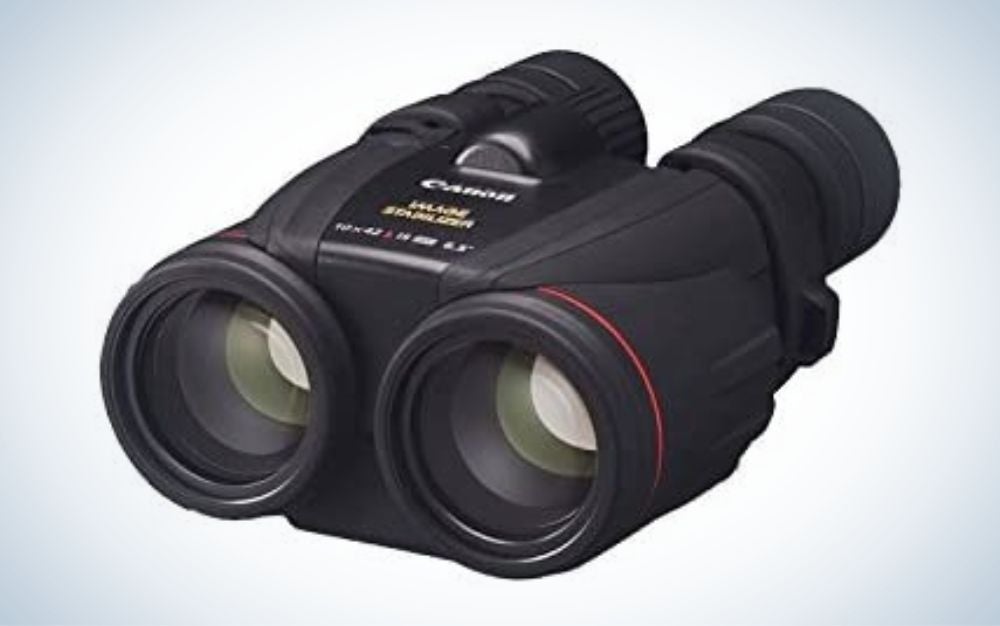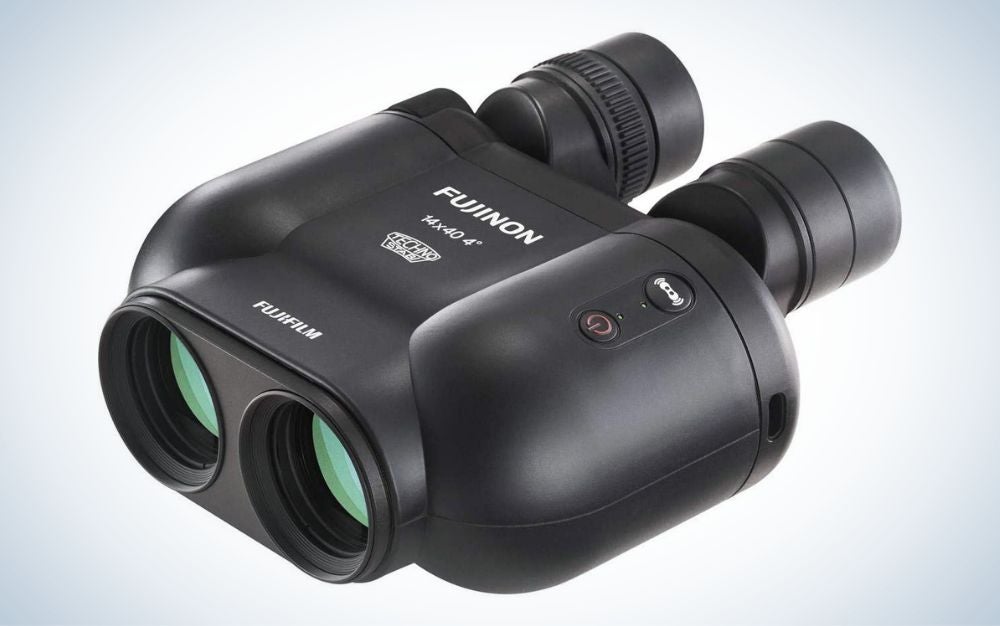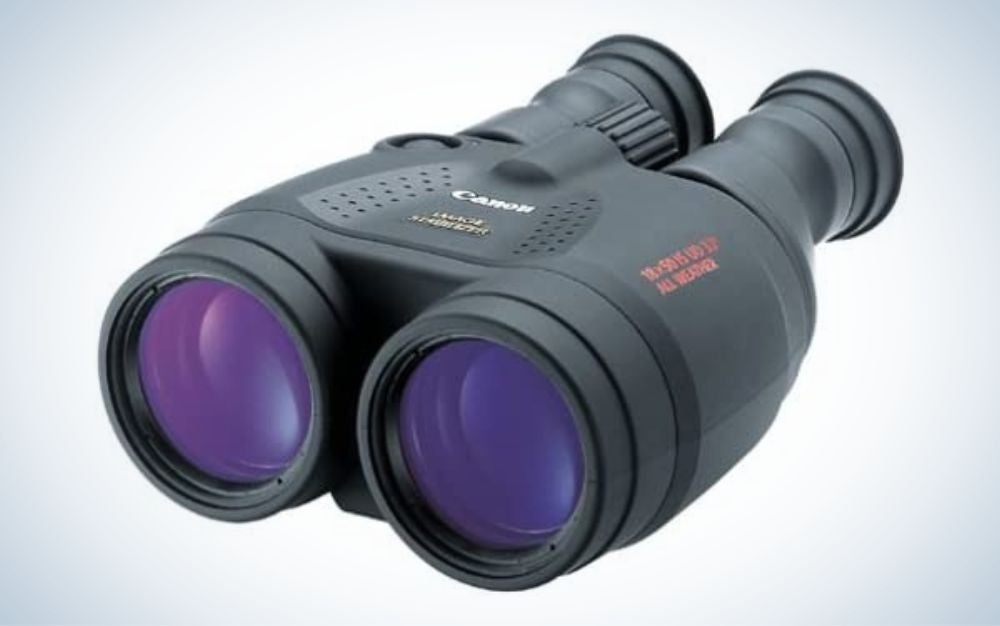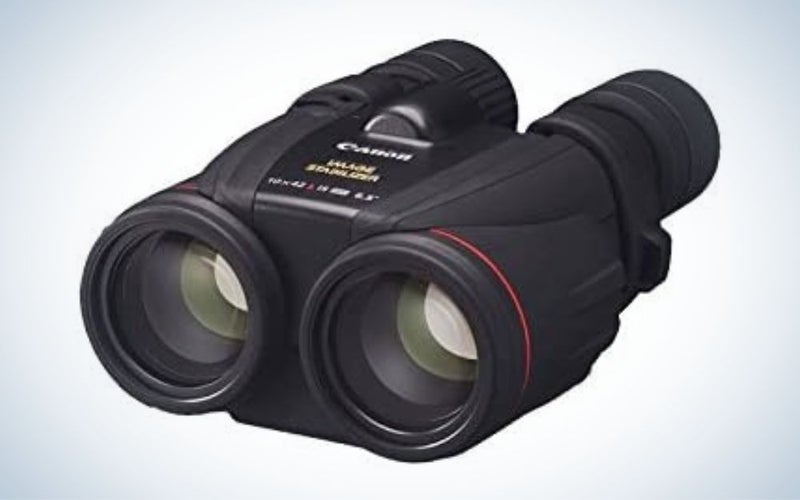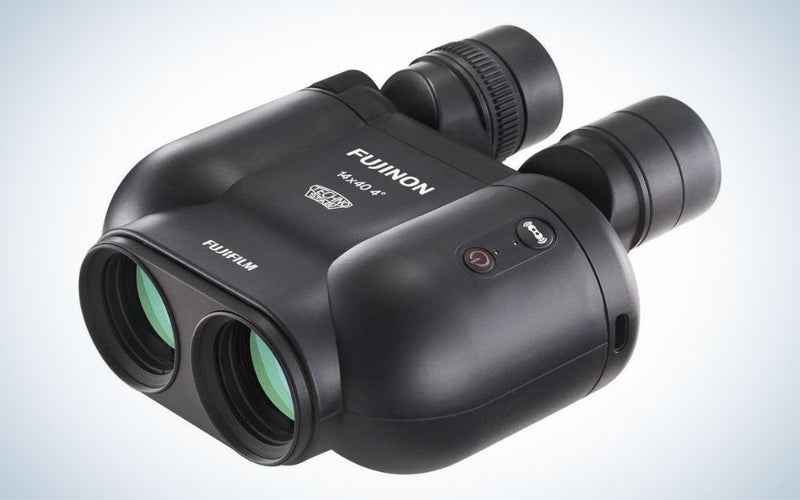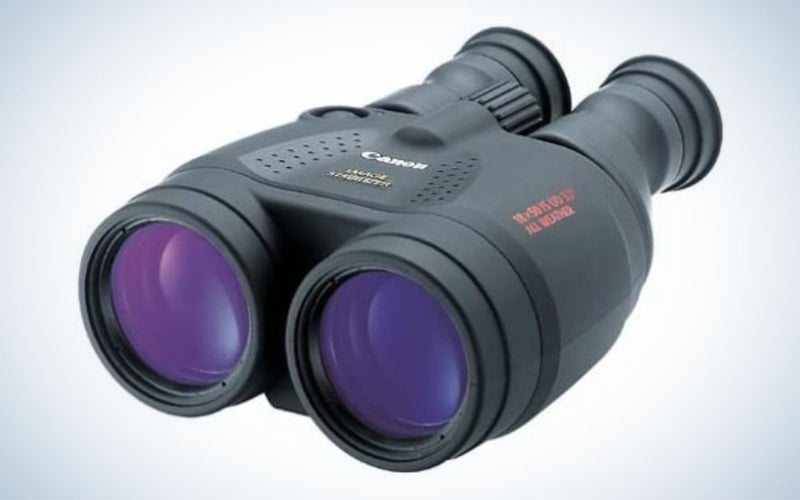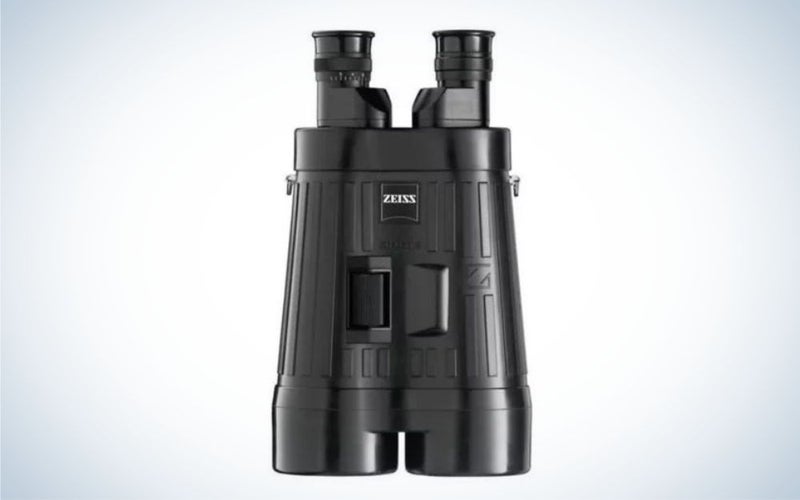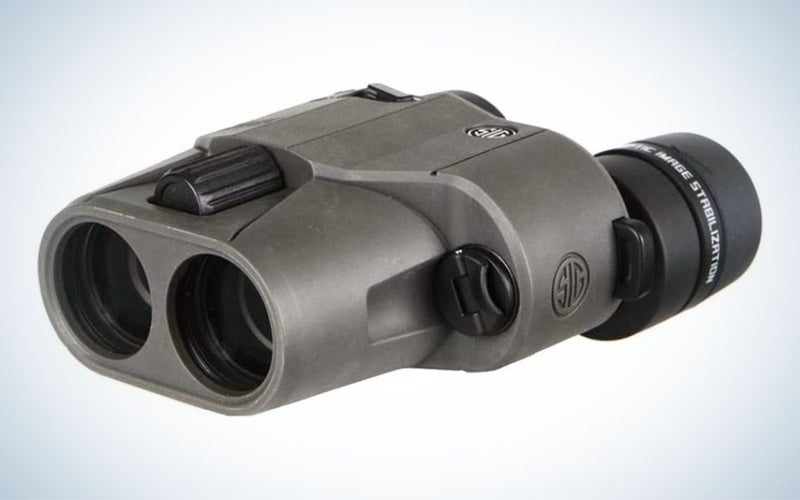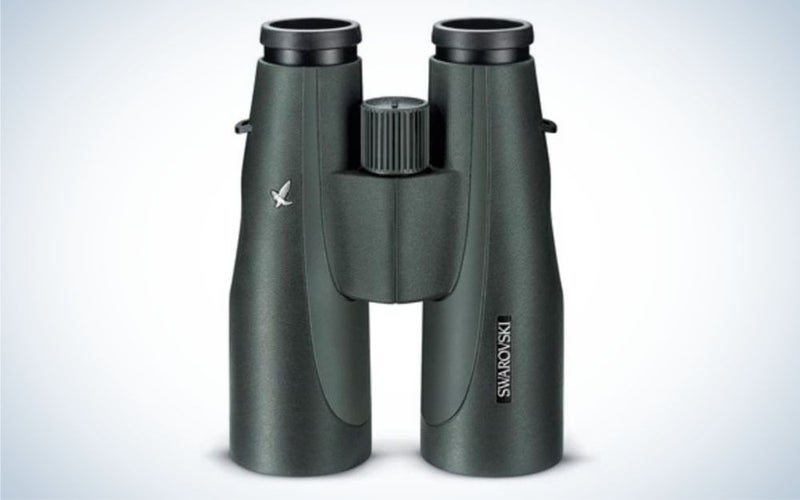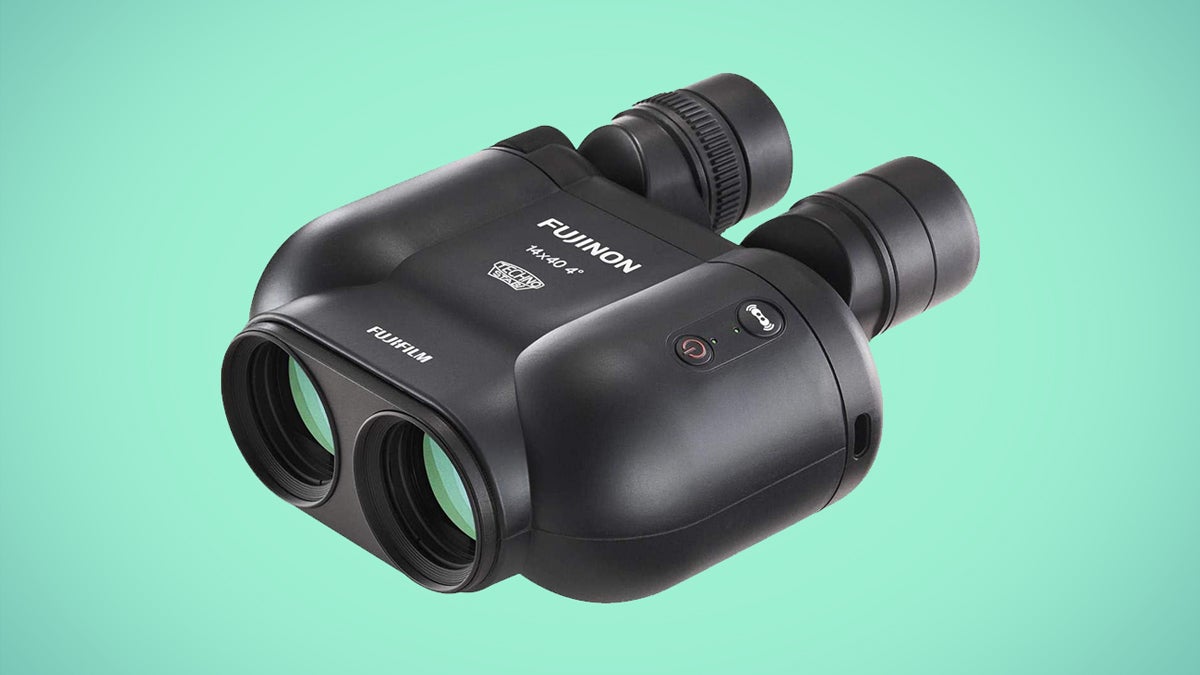
Long-range binoculars are a chore to hand hold steady enough to see clearly, which is why image stabilized binoculars are so helpful. Oftentimes, a regular pair of binoculars will get the job done with minimal fuss, especially if you know some good hand holding techniques or have a tripod. But sometimes, you don’t want to have the extra gear on you, and a handheld setup won’t cut it. The fact is, there are times when image stabilization is borderline necessary to get the job done. When that’s the case, the best image stabilized binoculars will help you see clearer with less work on your part.
- Best overall: Canon 10×42 L Image Stabilization Waterproof Binoculars
- Best marine binoculars: Fujinon TS-X 1440 14×40
- Best for astrology: Canon 18×50 IS All Weather
- Best premium: Zeiss T* S 20×60 Image Stabilizing Binoculars
- Best for hunting: Sig Sauer ZULU6 10×30
- Best for birding: Swarvoski Optiks SLC 15×56
Things to consider when looking for the best pair of image stabilized binoculars
Understanding binocular numbers
When you start to look around at binoculars–image stabilized or not–you’ll notice two numbers in the name of every pair. Those numbers provide two key specs upfront that will help you make your decision. The first number refers to the magnification. The second tells you the diameter of the two objective lenses–or the lenses closest to your subject–within the binoculars, measured in millimeters.
So, for example, the Canon 18×50 IL All Weather binoculars have a magnification of 18x, and the objective lenses are 50mm.
Objective lens size
As mentioned, the objective lens size refers to the diameter of the lens closest to your subject (at the very front of the binoculars). A larger objective lens will let in more light, resulting in a brighter image. For general purpose use, 30-50mm is plenty. But, if you plan to be hunting at dusk or dawn or want to use your binoculars for stargazing, look for something over 50mm. They get heavier as you increase objective lens size, though, so it is a bit of a balancing act.
Magnification
Where image stabilized binoculars really come into their own is at longer magnifications. As you increase magnification, holding standard binoculars by hand becomes progressively more difficult. However, through gyroscopic, electrical, or mechanical image stabilization, binoculars can push the limits of usable sight magnification to levels beyond the capabilities of traditional hand holding techniques.
The magnification you need will depend on how you plan to use your binoculars. For hunting, a magnification of around 8-10x will be ideal for most situations. You won’t want much higher because the field of view gets narrower as you get into higher magnifications. That means you will have less chance of catching wildlife moving across a vast landscape since you’re seeing such a tiny sliver. For stargazing, a subject where the field of view isn’t as important, look for a magnification between 10-20x.
Twilight coefficient
The twilight coefficient is a number used to express the amount of light a pair of binoculars allows to pass through. To put it simply, the more light that is available through the viewfinder, the brighter and clearer the image output of the binoculars. To determine the twilight coefficient of a pair of binoculars, calculate the square root of the magnification level multiplied by the available aperture of the objective lens. While this number isn’t perfect as other factors, such as lens coatings, can alter the transmission of light, it is a good starting point to determine how bright your final image will be.
Field of view
Manufacturers often measure field of view in one of two ways. For this article, we will be referring to the angular field of view. That means that out of the 360 degrees, your angular field of view is the span of view you will be able to see through the lenses.
Another popular way of measuring field of view is based on the distance visible at 1000 yards or meters. For example, you may see a field of view measurement of 331 feet at 1000 yards. This measurement tells us that at 1000 yards, we can expect to see 331 feet across.
Water, dust, and fog proofing
Knowing the environment where you intend to use your image stabilized binoculars will help you decide what type of weatherproofing is necessary. For example, marine environments can experience conditions that change from as flat as glass to turbulent and treacherous in a matter of moments. In those situations, it is important that your optics can hold up despite the harshest conditions. Look for a fully waterproof pair if you will be using your binoculars in such locations. An IPX rating of 7 or greater implies waterproofing capable of full submersion for a period of time.
Even while hunting or star gazing, rapid changes in ambient temperature can impact humidity levels and damage optics ill-suited for the task at hand. You may not need fully waterproof binoculars, but at minimum, a water-resistant set will be helpful. Fog proof binoculars will also be helpful in such environments.
Weight
Image stabilized binoculars are notoriously bulkier in size and weight. Depending on the method of stabilization used, some binoculars can be cumbersome if sustained use is necessary. Consider using an alternative harness for larger equipment or, when applicable, a tripod mount to relieve the strain. In situations where your binoculars need to be close at hand throughout the day, a lightweight and portable pair of optics might be the deciding factor in your purchasing decision.
Here are our picks for the best image stabilized binoculars in 2022
Best overall: Canon 10×42 L Image Stabilization Waterproof Binoculars
Canon
Why it made the cut: When choosing the best overall image stabilized binoculars, we wanted a pair that covered a wide range of activities since image stabilized binoculars can be a hefty investment. That’s where the Canon 10×42 L IS WP fits the bill.
Key features:
- Magnification: 10x
- Field of view: 6.2 degrees
- Twilight coefficient: 20.49
- Waterproofing: IPX4
Pros:
- Great magnification for multi-use
- Ultrafine focus manipulation
- Screw adjusting eyecups
Cons:
- Have to hold the stabilization button while in use
Product Description
10×42 is the perfect magnification level for anyone looking for a pair of binoculars that will do it all. From birding to ball games and hunting, Canon made one of the best all-around binoculars. Since image stabilized binoculars often come with a price tag comparable to a used sedan, having a robust pair that suits all needs can be extremely desirable.
The large focus throw on these optics makes it super easy to make ultrafine adjustments, ensuring you will have the sharpest image possible. Another feature that adds to the overall experience is the screw-adjusting eyecups. Simply turn the eye cup clockwise or counterclockwise to adjust to the desired depth to help you see the entire picture.
The only drawback we found with the Canon 10×42 L IS WP is that you have to continuously hold down the IS button for powered image stabilization. While it wasn’t a large inconvenience, it took some time to get used to and detracted from the overall experience.
Best marine binoculars: Fujinon TS-X 1440 14×40
Fujifilm
Why it made the cut: Marine environments are demanding of any piece of equipment utilized in these locations. The Fujinon TS-X 1440 stands up to this test and outshines its competitors with superior performance making.
Key features:
- Magnification: 14x
- Field of view: 4 degrees
- Twilight coefficient: 23.66
- Waterproofing: IPX7
- Weight: 2.9 pounds
Pros:
- Floats in water
- Highest degree of vibration correction in the industry
- Low image lag
Cons:
- Heavy
Product Description
Offering up to ±6 degrees of vibration correction, the Fujinon TS-X 1440 has achieved a level of unprecedented image stabilization. Holding binoculars steady on solid land can be hard enough but is next to impossible on a moving boat. The high level of image stabilization will be very beneficial as a result.
With a waterproofing rating of IPX7, the Fujinon TS-X 1440 make a fantastic choice for anyone needing high-performance binoculars in marine environments. And on top of being waterproof, they float in the water. So if you should get knocked by a rogue wave and drop the binoculars in the water, you’ll have a chance at retrieving them instead of watching them sink to the bottom of the ocean.
Whether spotting other vessels, whale watching, or scanning the horizon for potential hazards, the Fujinon Stabi series of binoculars have been the preferred choice in image stabilized binoculars for many mariners for many years.
Best for astrology: Canon 18×50 IS All Weather
Canon
Why it made the cut: Canon is well known for bringing superb imaging technology to the professional & prosumer markets for decades. Utilizing the same technology built into their flagship L series lenses, the Canon IS series of binoculars offer great image quality and an ideal level of magnification for astrology.
Key features:
- Magnification: 18x
- Field of view: 3.7 degrees
- Twilight coefficient: 30
- Waterproofing: Water-resistant (not suited for submersion)
- Weight: 2.6 pounds
Pros:
- Long magnification range
- Near silent image stabilization
- 3/8 tripod socket
Cons:
- Weatherproofing could be better
Product Description
The Canon 18×50 IS binoculars offer a long magnification range with an outstanding twilight coefficient. These are important factors to astrologers who utilize handheld imaging equipment while looking at the night sky. In addition, with the included 3/8 tripod mount, the Canon 18×50 IS binoculars have the ability to be quickly mounted to an auxiliary tripod when other imaging equipment is in use.
The Canon IS series of binoculars are water-resistant, helping them stand up to rigorous use in all environments. However, they are not able to stand up to being fully submerged in water. As a result, you will have to take some care with them in wet locations. Luckily, if you are stargazing, you are dealing with clear skies, so the lower level of weathersealing shouldn’t be a problem.
Best premium: Zeiss T* S 20×60 Image Stabilizing Binoculars
Zeiss
Why it made the cut: Zeiss has firmly established their authority in producing top-shelf optics over the years. Paired with their state-of-the-art mechanical image stabilization, the Zeiss S series of image stabilized binoculars are some of the best optics money can buy.
Key features:
- Magnification: 20x
- Field of view: 5.2 degrees
- Twilight coefficient: 34.6
- Waterproofing: Not listed
- Weight: 3.7 pounds
Pros:
- Superb low light performance
- Exceptional image quality
- High magnification
Cons:
- Extremely expensive
Product Description
From missions on the International Space Station to scanning great distances planet side, the Zeiss S series binoculars were created to reach distant locations with exceptional light transmission. It features a Porro prism, which helps produce a bright, sharp image. The 60mm lens also brings in lots of light, providing even more brightness. As a result, it is an excellent tool for glassing at dawn or dusk or even stargazing.
Eliminating handheld shake at magnifications over 15x on traditional binoculars is a difficult task without the aid of additional support systems. Yet Zeiss removes the need for such devices with its unique mechanical stabilization system. And it doesn’t require battery power to do so. At 20x, the 20×60 S has an exceptional level of magnification, putting it in a class of its own.
There is a downside to all the quality you get. The price point is extremely high, making it a big investment. And, with the Porro Prism and large objective lens size, you get a bulkier, heavier product. At 3.7 pounds, you won’t want to be holding these by hand for terribly long.
Best for hunting: Sig Sauer ZULU6 10×30
Why it made the cut: The ZULU6 10×30 allows hunters to identify game at long distances without sacrificing weight or portability.
Key features:
- Magnification: 10x
- Field of view: 5.2 degrees
- Twilight coefficient: 17.3
- Waterproofing: IPX4
- Weight: 1.2 pounds
Pros:
- Lightest binoculars in its class
- Compact form factor
- Impressive battery life
Cons:
- Included carrying case could be better
Product Description
The ZULU6 from Sig Sauer is the image stabilized version of its already popular ZULU lineup. With its two-axis image stabilization gimbal system, the ZULU6 offers the same level of stabilization as a mounted spotting scope in a compact and portable form factor.
They weigh just 1.3 pounds, which is lighter than any other option on our list. So if you like to go light and fast on your hunts, these will meet your needs. Additionally, the lenses have abrasion-resistant coatings for better protection, even while walking through heavy brush.
With a waterproof rating of IPX4, the ZULU6 series of binoculars are ready for any hunt in any weather condition. These binoculars will hold up even if you get caught in a torrential downpour or epic snowstorm.
Best for birding: Swarvoski SLC 15×56
Swarvoski
Why it made the cut: Image stabilization with the 15x magnification and a large effective objective lens diameter make the Swarvoski SLC 15×56 ideal for birders.
Key features:
- Magnification: 15x
- Field of view: 4.5 degrees
- Twilight coefficient: 29
- Waterproofing: Not listed
- Weight: 2.6 pounds
Pros:
- Clear, bright image
- 3/8 tripod mount
- Ergonomic
Cons:
- Heavy for single handed use
- Pricey
Product Description
The Swarvoski SLC series of image stabilized binoculars boast a 93% light transmission allowing for superior image quality and detail retention. So when wildlife becomes more active late in the day, the Swarvoski SLC 15×56 make an excellent choice for observing these shy creatures in their natural habitat undisturbed.
With its ergonomic design, the SLC series brings image stabilization in a form factor that will combat fatigue, making long periods of bird watching a more enjoyable experience. These are not cheap binoculars by any means. It will be an investment to purchase them, but you’ll also get great quality, a lifetime warranty for the optics, and a ten-year warranty for other parts.
FAQs
Q: Are image-stabilized binoculars worth it?
Whether or not image stabilized binoculars are worth it comes down to a matter of perspective. Objectively speaking, in slower-moving environments, such as bird watching or even hunting, the added cost of image stabilization is harder to justify since various hand-holding techniques can drastically improve your experience. On the other hand, in marine environments and astronomy, where objects are moving in opposing directions from your vantage point, image stabilized binoculars can have a noticeable effect during your use.
Q: How do image stabilizing binoculars work?
Image stabilization works in one of three ways: gyroscopic, electronic, or mechanical. With gyroscopic image stabilization, internal gyroscopes provide a reference that prisms adjust to during motion to keep the image aligned in your sight picture. Electronic stabilization works similarly via accelerometers to send signals to a collection of servos that automatically adjust your binocular’s prisms during motion. Lastly, with mechanical image stabilization, small free-moving counterweights are attached to the prisms to pull them into the correct position when any inertial force is applied to the binoculars.
Q: How do you stabilize binoculars?
There are a few techniques you can use to help stabilize your non-image stabilized binoculars. For starters, when holding your binoculars, fold in your elbows and tuck them into your chest to brace your binoculars similarly to a tripod. If you have the option of laying down, placing your elbows on the ground is one of the best ways to stabilize your binoculars for a clear image. If image stabilized binoculars are outside of your price range, consider buying heavier binoculars. It seems counterintuitive, but heavier binoculars are easier to hold steady due to their mass.
Q: How can I tell if the image stabilizer is working?
Each brand is slightly different on signs that the image stabilizer is operating normally. Some brands have indicator lights to show operation. With other brands, the image stabilizer makes motorized noise during use, cluing you in that it is operational. One sure-fire way to verify that your binoculars are working is to hold them up to your face and pan from left to right. If the image stabilization system is powered and online, the image you are seeing should “drag” slightly behind your movements. This is the image stabilization trying to compensate for your movements. If the system is not powered on or functioning incorrectly, the image in your sight picture should be moving at the exact same speed as your movements from side to side.
Final thoughts on image stabilized binoculars
In this article, we had the opportunity to look at a wide variety of image stabilized binoculars. While each one performed the same basic function, the binoculars we reviewed each had unique features that set them apart from the others.
Methodology
Because of their specific uses and complexity, manufacturers still prefer to invest in standard binoculars. That means that a lot of the technology we looked at has been around for some time. The one exception is the Fujinon 1440 14×40, which outshines the competition with 6 degrees of vibration correction. In order to clearly identify the best of the best in image stabilized binoculars, we looked at battery life, twilight coefficient, field of view, vibration correction, weight, and magnification power, all as important factors.
Image stabilized binoculars are a hefty investment, so we understand why you would want to do thorough research when determining which is the right pair for you. Whether you’re in the marine industry, an avid hunter, an astrologer, or someone who simply enjoys a nice day of bird watching, we did our best to ensure that there is a pair of binoculars in our list of image stabilized binoculars for you.
The post Best image stabilized binoculars of 2022 appeared first on Popular Photography.
